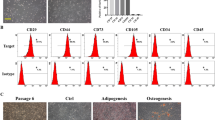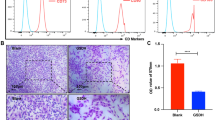Abstract
Bone marrow mesenchymal stem cells (BMSCs)-based therapy has emerged as a desirable modality for the treatment of tissue injury with promising therapeutic effects; however, low survival rate of transplanted cells due to harsh microenvironment with hypoxia and oxidative stress results in hampered therapeutic benefits of this therapy. Curcumin, a natural bioactive product, is a dietary component which has gained increasing attention owing to its beneficial health properties. Here, we reported the protective effects of curcumin pretreatment on BMSCs injury induced by hydrogen peroxide (H2O2), which was used as ROS source of oxidative stress in vitro. We found that curcumin pretreatment remarkably inhibited H2O2-induced cell viability reduction, LDH leakage, and cell apoptosis in BMSCs. Moreover, curcumin pretreatment prevented H2O2-induced mitochondrial dysfunction via suppressing adenosine triphosphate loss, reactive oxygen species accumulation, and membrane potential decline. In addition, curcumin pretreatment markedly reduced the phosphorylation levels of Akt and Erk1/2. Taken together, our investigations demonstrated that curcumin pretreatment conferred BMSCs the ability to survive from H2O2-induced oxidative stress, which might attribute to its prevention of mitochondrial dysfunction and deactivation of Akt and Erk1/2 signaling pathways. Thus, this study sheds more light on the pharmacological mechanisms of curcumin, and suggests that BMSCs preconditioned with curcumin might be an effective way for cell therapy in tissue repair treatment.





Similar content being viewed by others
References
Wang Y, Chen X, Cao W, Shi Y (2014) Plasticity of mesenchymal stem cells in immunomodulation: pathological and therapeutic implications. Nat Immunol 15:1009–1016
Prockop DJ, Oh JY (2012) Mesenchymal stem/stromal cells (MSCs): role as guardians of inflammation. Mol Ther 20:14–20
Karp JM, Leng Teo GS (2009) Mesenchymal stem cell homing: the devil is in the details. Cell Stem Cell 4:206–216
Russo V, Young S, Hamilton A, Amsden BG, Flynn LE (2014) Mesenchymal stem cell delivery strategies to promote cardiac regeneration following ischemic injury. Biomaterials 35:3956–3974
Wang J, Cui W, Ye J, Ji S, Zhao X, Zhan L, Feng J, Zhang Z, Zhao Y (2012) A cellular delivery system fabricated with autologous BMSCs and collagen scaffold enhances angiogenesis and perfusion in ischemic hind limb. J Biomed Mater Res A 100:1438–1447
Song H, Cha MJ, Song BW, Kim IK, Chang W, Lim S, Choi EJ, Ham O, Lee SY, Chung N, Jang Y, Hwang KC (2010) Reactive oxygen species inhibit adhesion of mesenchymal stem cells implanted into ischemic myocardium via interference of focal adhesion complex. Stem Cells 28:555–563
Liu P, Feng Y, Dong C, Yang D, Li B, Chen X, Zhang Z, Wang Y, Zhou Y, Zhao L (2014) Administration of BMSCs with muscone in rats with gentamicin-induced AKI improves their therapeutic efficacy. PLoS ONE 9:e97123
Xinaris C, Morigi M, Benedetti V, Imberti B, Fabricio AS, Squarcina E, Benigni A, Gagliardini E, Remuzzi G (2013) A novel strategy to enhance mesenchymal stem cell migration capacity and promote tissue repair in an injury specific fashion. Cell Transplant 22:423–436
Navarro-Yepes J, Burns M, Anandhan A, Khalimonchuk O, del Razo LM, Quintanilla-Vega B, Pappa A, Panayiotidis MI, Franco R (2014) Oxidative stress, redox signaling, and autophagy: cell death versus survival. Antioxid Redox Signal 21:66–85
Orrenius S, Gogvadze V, Zhivotovsky B (2007) Mitochondrial oxidative stress: implications for cell death. Annu Rev Pharmacol Toxicol 47:143–183
Weinberg E, Maymon T, Weinreb M (2014) AGEs induce caspase-mediated apoptosis of rat BMSCs via TNFα production and oxidative stress. J Mol Endocrinol 52:67–76
Zhang F, Ren T, Wu J (2015) TGF-β1 induces apoptosis of bone marrow-derived mesenchymal stem cells via regulation of mitochondrial reactive oxygen species production. Exp Ther Med 10:1224–1228
Rojkinda M, Domínguez-Rosales J-A, Nieto N, Greenwel P (2002) Role of hydrogen peroxide and oxidative stress in healing responses. Cell Mol Life Sci 59:1872–1891
Yang SR, Park JR, Kang KS (2015) Reactive oxygen species in mesenchymal stem cell aging: implication to lung diseases. Oxid Med Cell Longev 2015:486263
Veal EA, Day AM, Morgan BA (2007) Hydrogen peroxide sensing and signaling. Mol Cell 26:1–14
Hwang SL, Yen GC (2009) Modulation of Akt, JNK, and p38 activation is involved in citrus flavonoid-mediated cytoprotection of PC12 cells challenged by hydrogen peroxide. J Agric Food Chem 57:2576–2582
Maurya AK, Vinayak M (2016) PI-103 and Quercetin attenuate PI3 K-AKT signaling pathway in T-Cell lymphoma exposed to hydrogen peroxide. PLoS ONE 11:e0160686
Hatcher H, Planalp R, Cho J, Torti FM, Torti SV (2008) Curcumin: from ancient medicine to current clinical trials. Cell Mol Life Sci 65:1631–1652
Esatbeyoglu T, Huebbe P, Ernst IM, Chin D, Wagner AE, Rimbach G (2012) Curcumin–from molecule to biological function. Angew Chem Int Ed Engl 51:5308–5332
Cremers NA, Lundvig DM, van Dalen SC, Schelbergen RF, van Lent PL, Szarek WA, Regan RF, Carels CE, Wagener FA (2014) Curcumin-induced heme oxygenase-1 expression prevents H2O2-induced cell death in wild type and heme oxygenase-2 knockout adipose-derived mesenchymal stem cells. Int J Mol Sci 15:17974–17999
Yagi H, Tan J, Tuan RS (2013) Polyphenols suppress hydrogen peroxide-induced oxidative stress in human bone-marrow derived mesenchymal stem cells. J Cell Biochem 114:1163–1173
Yu C, Kim BS, Kim E (2016) FAF1 mediates regulated necrosis through PARP1 activation upon oxidative stress leading to dopaminergic neurodegeneration. Cell Death Differ 23:1873–1885
Eruslanov E, Kusmartsev S (2010) Identification of ROS using oxidized DCFDA and flow-cytometry. Methods Mol Biol 594:57–72
Lee YJ, Park KH, Park HH, Kim YJ, Lee KY, Kim SH, Koh SH (2009) Cilnidipine mediates a neuroprotective effect by scavenging free radicals and activating the phosphatidylinositol 3-kinase pathway. J Neurochem 111:90–100
Prathapan A, Vineetha VP, Raghu KG (2014) Protective effect of Boerhaavia diffusaL. against mitochondrial dysfunction in angiotensin II induced hypertrophy in H9c2 cardiomyoblast cells. PLoS ONE 9:e96220
Han Z, Jing Y, Zhang S, Liu Y, Shi Y, Wei L (2012) The role of immunosuppression of mesenchymal stem cells in tissue repair and tumor growth. Cell Biosci 2:8
Liu P, Feng Y, Wang Y, Zhou Y (2014) Therapeutic action of bone marrow-derived stem cells against acute kidney injury. Life Sci 115:1–7
Fang J, Chen L, Fan L, Wu L, Chen X, Li W, Lin Y, Wang W (2011) Enhanced therapeutic effects of mesenchymal stem cells on myocardial infarction by ischemic postconditioning through paracrine mechanisms in rats. J Mol Cell Cardiol 51:839–847
Zhang H, Hou JF, Shen Y, Wang W, Wei YJ, Hu S (2010) Low level laser irradiation precondition to create friendly milieu of infarcted myocardium and enhance early survival of transplanted bone marrow cells. J Cell Mol Med 14:1975–1987
Sart S, Ma T, Li Y (2014) Preconditioning stem cells for in vivo delivery. Biores Open Access 3:137–149
Qiao H, Zhang R, Gao L, Guo Y, Wang J, Zhang R, Li X, Li C, Chen Y, Cao F (2016) Molecular imaging for comparison of different growth factors on bone marrow-derived mesenchymal stromal cells’ survival and proliferation in vivo. Biomed Res Int 2016:1363902
Shehzad A, Rehman G, Lee YS (2013) Curcumin in inflammatory diseases. BioFactors 39:69–77
Daverey A, Agrawal SK (2016) Curcumin alleviates oxidative stress and mitochondrial dysfunction in astrocytes. Neuroscience 333:92–103
Xiao Y, Li X, Cui Y, Zhang J, Liu L, Xie X, Hao H, He G, Kander MC, Chen M, Liu Z, Verfaillie CM, Zhu H, Lei M, Liu Z (2014) Hydrogen peroxide inhibits proliferation and endothelial differentiation of bone marrow stem cells partially via reactive oxygen species generation. Life Sci 112:33–40
Zhou H, Yang J, Xin T, Li D, Guo J, Hu S, Zhou S, Zhang T, Zhang Y, Han T, Chen Y (2014) Exendin-4 protects adipose-derived mesenchymal stem cells from apoptosis induced by hydrogen peroxide through the PI3 K/Akt-Sfrp2 pathways. Free Radic Biol Med 77:363–375
Wei Y-H, Lee H-C (2002) Oxidative stress, mitochondrial DNA mutation and impairment of antioxidant enzymes in aging. Exp Biol Med 227:671–682
Halliwell B (2012) Free radicals and antioxidants: updating a personal view. Nutr Rev 70:257–265
Hocsak E, Racz B, Szabo A, Mester L, Rapolti E, Pozsgai E, Javor S, Bellyei S, Gallyas F Jr, Sumegi B, Szigeti A (2010) TIP47 protects mitochondrial membrane integrity and inhibits oxidative-stress-induced cell death. FEBS Lett 584:2953–2960
Kwon SH, Hong SI, Kim JA, Jung YH, Kim SY, Kim HC, Lee SY, Jang CG (2011) The neuroprotective effects of Lonicera japonica THUNB. against hydrogen peroxide-induced apoptosis via phosphorylation of MAPKs and PI3 K/Akt in SH-SY5Y cells. Food Chem Toxicol 49:1011–1019
Wada T, Penninger JM (2004) Mitogen-activated protein kinases in apoptosis regulation. Oncogene 23:2838–2849
Bisht K, Wagner KH, Bulmer AC (2010) Curcumin, resveratrol and flavonoids as anti-inflammatory, cyto- and DNA-protective dietary compounds. Toxicology 278:88–100
Acknowledgements
This work was supported by the National Natural Science Foundation of China (No. 81301632) and Shaanxi Provincial Natural Science Foundation (No. 2014JM4179).
Author information
Authors and Affiliations
Corresponding author
Ethics declarations
Conflict of interest
The authors declare that they have no conflict of interest with this article.
Rights and permissions
About this article
Cite this article
Wang, X., Gao, J., Wang, Y. et al. Curcumin pretreatment prevents hydrogen peroxide-induced oxidative stress through enhanced mitochondrial function and deactivation of Akt/Erk signaling pathways in rat bone marrow mesenchymal stem cells. Mol Cell Biochem 443, 37–45 (2018). https://doi.org/10.1007/s11010-017-3208-5
Received:
Accepted:
Published:
Issue Date:
DOI: https://doi.org/10.1007/s11010-017-3208-5




